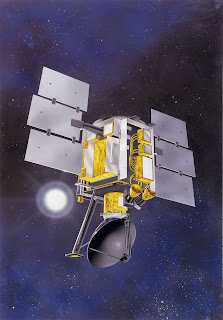JPL Wind Watcher Blows Into its Second Decade
 NASA's Quick Scatterometer, or QuikScat, mission was conceived, developed and launched less than two years after the unexpected loss of the Japan Aerospace Exploration Agency's Advanced Earth Observing Satellite-1 spacecraft, which carried the NASA Scatterometer in June 1997. Just two years later, on June 19, 1999, the QuikScat spacecraft carrying JPL's SeaWinds instrument was launched from Vandenberg Air Force Base, Calif.
NASA's Quick Scatterometer, or QuikScat, mission was conceived, developed and launched less than two years after the unexpected loss of the Japan Aerospace Exploration Agency's Advanced Earth Observing Satellite-1 spacecraft, which carried the NASA Scatterometer in June 1997. Just two years later, on June 19, 1999, the QuikScat spacecraft carrying JPL's SeaWinds instrument was launched from Vandenberg Air Force Base, Calif.Since its launch a decade ago, QuikScat has advanced Earth science research and helped improve environmental predictions using measurements of global radar backscatter from Earth’s ocean, land and ice surfaces. QuikScat data help scientists better understand and predict the processes that drive our climate, such as ocean circulation and the global water cycle.
QuikScat data have revolutionized operational weather and storm forecasting. According to Paul Chang, ocean winds science team lead at the National Oceanic and Atmospheric Administration's National Environmental Satellite, Data, and Information Service/Center for Satellite Applications and Research, Camp Springs, Md., "QuikScat observations are now used around the world to support operational forecasting and warning of phenomena ranging from tropical and extratropical cyclones, fronts, localized coastal wind events such as gap winds and sea conditions driven by winds, to sea and lake ice extent and motion. The 10 years of observations from the QuikScat mission have provided critical information for the monitoring, modeling, forecasting and research of the atmosphere, oceans and climate."
In addition to its numerous weather forecasting and climate research applications, QuikScat data also help monitor changes in Arctic sea ice and icebergs, as well as snow and soil moisture changes on land. QuikScat's reliability, quality, resolution, coverage and longevity have made it the only global ocean wind speed and direction data to date that are appropriate for climate studies.
QuikScat accurately measures the speed and direction of winds at the ocean surface over 90 percent of Earth's surface twice a day, providing data in areas not sampled by buoys and other wind platforms. The scatterometer works by measuring the strength of radar signals that are bounced back from the ocean surface. As wind speeds increase, they disturb the ocean surface, generating more small waves. These small waves reflect the radar energy toward the radar, resulting in a stronger reflection. This is similar to the way that wind blowing at the beach on a sunny day causes the ocean surface to sparkle.
NASA's Jet Propulsion Laboratory, Pasadena, Calif., developed QuikScat and manages the mission for NASA’s Science Mission Directorate, Washington. QuikScat's mission team includes personnel from JPL; NASA's Goddard Space Flight Center in Greenbelt, Md.; Ball Aerospace and Technologies Corp., of Boulder, Colo.; the University of Colorado's Laboratory for Atmospheric and Space Physics in Boulder; and numerous principal investigators funded by NASA’s Ocean Vector Winds science team.



 12:31 AM
12:31 AM
 sheldon
,
sheldon
,















0 Response to "JPL Wind Watcher Blows Into its Second Decade"
Post a Comment